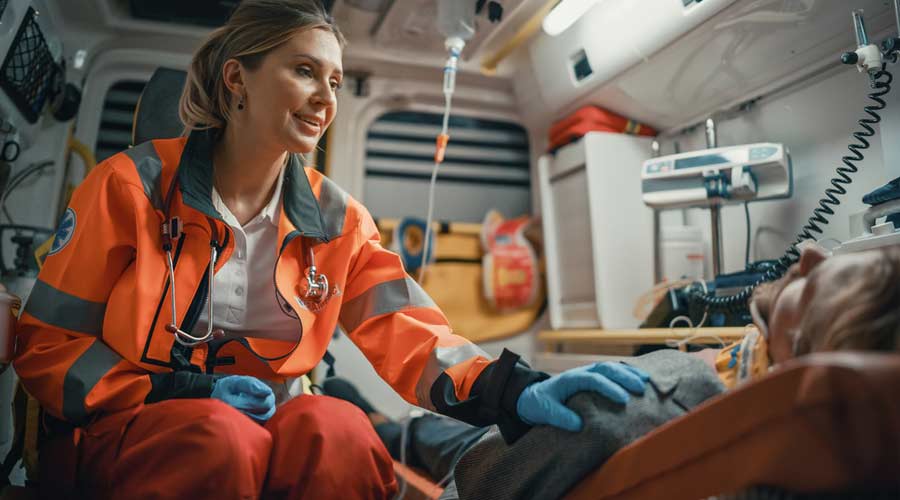The contamination of emergency medical vehicles with pathogenic microbes poses a potential threat to public health, considering the many millions of ambulance transports each year. This risk of infection is to the patients, people who travel with them and the paramedic first responders whose work involves pre- or inter-hospital transfer.
Determining the risk should facilitate the advancement of best practices to enhance infection control of routine outbreaks and during a major emergency, such as a disease pandemic or bioterrorism event.
No systems exist to evaluate whether a patient who has developed a healthcare-acquired infection (HAI) while in the hospital was exposed during the hospital stay or in the pre-hospital — ambulance transport — setting. So it is recommended that designated subject matter experts in infection prevention are incorporated as liaisons in the pre-hospital setting between the pre-hospital and hospital environments.
Many recent international studies, including those from the National Center for Biotechnology Information, Assuit University and IntechOpen Ltd., show the contamination of emergency service vehicles with microbes from body fluids or excreta.
Notably, ambulances were contaminated with the difficult-to-treat Gram-positive bacterium, methicillin-resistant Staphylococcus aureus (MRSA). One study found that among 21 ambulances, 47.6 percent of surface swabbings were positive for MRSA. Further, “large numbers of microbes” were isolated from helicopter air ambulances, according to the study.
Gram-negative coliforms of a variety of genera including Enterobacter, Klebsiella and Escherichia were commonly detected, suggesting contamination with fecal or soil matter.
Emergency care equipment was discovered to also be a source of contamination. Sphygmomanometer cuffs, stethoscopes and respirator masks frequently carried enterococci and S. aureus. In one study, 57 percent of patient-ready trauma equipment swabbed in vehicles at six hospitals tested positive for blood contamination. Likewise, of 50 stethoscopes used by paramedics, 32 percent tested positive for MRSA.
As with the established protocols and processes in the hospital setting, strict uniform protocols for cleaning efficiency also should be implemented in the pre-hospital setting. Education and training for emergency medical services (EMS) personnel on standard operating procedures for cleaning and disinfection is recommended to optimize consistent and correct methods of cleaning, particularly for high-touch surfaces.
To make technical recommendations involving surface disinfection methods and frequency, use of ultraviolet light, and air scrubbing, it would be necessary to evaluate and compare methods to determine if they are more effective than current practices. Additional research of the EMS environment is also recommended.
Research has established that all types of EMS vehicles can act as vectors for infectious microbes. Organisms most associated with HAIs were detected in the patient-care compartment of ambulances across a variety of different surfaces.
Multi-drug resistant organisms (MDRO) found in the ambulance environment are concerning because of the difficulty in treating the associated infections. Transport vehicles could serve as a source of transmission for HAIs to patients and EMS personnel. Items of equipment that are handled frequently by paramedics might be at heightened risk of contamination and should be prioritized for regular disinfection.
Future work is warranted regarding assessing the effectiveness of cleaning protocols and the factors that affect decontamination in the ambulance. These investigations could provide scientific data to prevent the transmission of organisms commonly associated with HAIs to transported patients and EMS personnel.
J. Darrel Hicks, BA, MESRE, CHESP, Certificate of Mastery in Infection Prevention, is the past president of the Healthcare Surfaces Institute. Hicks is nationally recognized as a subject matter expert in infection prevention and control as it relates to cleaning. He is the owner and principal of Safe, Clean and Disinfected. His enterprise specializes in B2B consulting, webinar presentations, seminars and facility consulting services related to cleaning and disinfection. He can be reached at darrel@darrelhicks.com, or learn more at www.darrelhicks.com.

 UF Health Hospitals Rely on Green Globes to Realize Their Full Potential
UF Health Hospitals Rely on Green Globes to Realize Their Full Potential How Healthcare Facilities Can Be Truly Disaster-Resilient
How Healthcare Facilities Can Be Truly Disaster-Resilient TriasMD Breaks Ground on DISC Surgery Center for San Fernando Valley
TriasMD Breaks Ground on DISC Surgery Center for San Fernando Valley Bigfork Valley Hospital Falls Victim to Data Breach
Bigfork Valley Hospital Falls Victim to Data Breach AI-Driven Facilities: Strategic Planning and Cost Management
AI-Driven Facilities: Strategic Planning and Cost Management